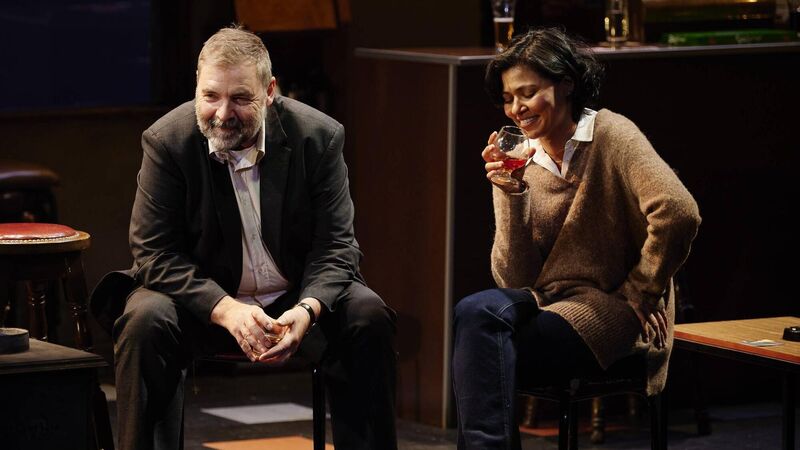Theatre review: Engrossing production of The Weir at the Abbey

Brendan Coyle and Jolly Abraham in Conor McPherson’s The Weir at the Abbey Theatre. Picture: Ros Kavanagh
★★★★☆
Show, don’t tell: so goes the old stricture. But one of the best things about Conor McPherson’s 1997 West End hit is that in telling, his characters do a lot of showing. Who are we, after all, if not the stories we choose to tell?
It’s a windy winter night, though “balmy enough”, as regulars Jack (Brendan Coyle) and Jim (Marty Rea) arrive at the local bar, run by Brendan (Sean Fox). It’s an authentically unlovely rural pub in Sarah Bacon’s rotating set: formica and uncomfortable vinyl-covered seats, rather than postcard olde Irish. Outside, an abandoned car sits, with musicians Eamonn Cagney and Courtney Cullen playing, atmospherically, if perhaps not very necessarily.
The banter and chat of the three bachelors absorbs us into their little world, with the news of the day revolving around local bigshot Finbar (Peter Cloonan) and Valerie (Jolly Abraham), the “blow-in” from Dublin he’s showing around.

As a window opens on small-town rivalries, it would be easy to think McPherson is about to embark into familiar dramatic terrain. Instead, he has an eye on the fantastic, as talk of a local “fairy road” brings each character to tell a story about their own brush with the supernatural.
What follows is an utterly engrossing succession of monologues, in which each character is satisfyingly delineated. Brendan Coyle’s Jack sheds his cranky, contrary mask, while the brilliant Marty Rea conjures a wonderfully distinctive, quirky, but very believable Jim. Peter Cloonan peels away the cash-splashing bravura of Finbar to reveal his vulnerability.
Under Caitriona McLaughlin’s astute direction, no beat, hesitation, or gesture is ill considered, and the balance between crowd-pleasing laughs and tension is well judged.
As the only woman, Jolly Abraham's Valerie is distinctive in more ways than one: as an urbanite, an American, and, for the trio, the intended audience. Yet her story, when we finally get to it, is the most wrenching of all, stemming from the worst kind of tragedy.
And it’s here, as McPherson’s neo-Gothic shifts from the supernatural to the deeply personal, that we realise we are all haunted, we all have ghosts that refuse to be silent.



